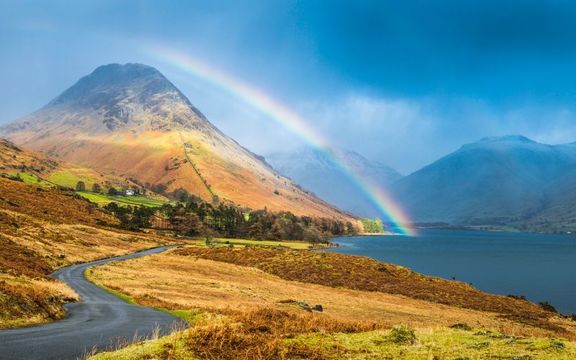
Lake District National Park, Cumbria, UKGetty
Dana Huntley leaves the cities and the crowded tourist sites behind.
Open throughout the year and specializing in outdoor pursuits from trekking and photography to bird-watching and mountain biking, the UK’s 15 national parks together cover seven percent of Great Britain. While the parks share in common incredibly diverse landscapes and wide-open spaces, they encompass as well pastoral villages, small market towns and a fascinating individual history.
In addition to the 10 parks introduced below, Wales’ Brecon Beacons, the Pembrokeshire Coastline, the South Downs, the North Yorkshire Moors, and Northumberland provide equally great visits.
Each of the parks has its own dedicated website offering complete visitor information on travel, places, activities, lodging, and dining. They are perfect for planning an adventure in Britain far from the masks of the madding crowd.
Exmoor, Somerset and Devon
A broad hilly moorland on the Bristol Channel, Exmoor was once a royal hunting forest. Its borders encompass 18,810 acres of West Somersworth and Devon. Follow the A36 west from Bridgewater to the National Park Centre in medieval Dunster or carry on along 34 miles of dramatic coastline to the picturesque harbor village of Lynmouth. Spot red deer on Haddon Hill. Catch the highest cliff in Britain at Combe Martin and watch wild Exmoor ponies grazing freely on the moors.
www.exmoor-nationalpark.gov.uk
View this post on Instagram
Dartmoor, Devon
South of Exmoor, Dartmoor National Park covers 368 square miles of Devon. Its largely open moorland landscape is broken by tors of granite bedrock, scores of hilly outcrops punctuating the countryside. Dartmoor is a favorite with walkers and trekkers, offering unfettered access and 450 miles of footpaths and bridleways. After a hike, visit Buckfast Abbey, Castle Drogo or the Iron Age village at Hound Tor. Learn about the park’s geology, wildlife and history at the visitor center in Princetown.
New Forest, Hampshire
Named Nova Foresta by William the Conqueror, this ancient hunting preserve sprawls across southwest Hampshire into Wiltshire and remains the largest unenclosed tract of heath, forest and pastureland in southern England. The rights of foresters granted in the 11th century remain today, such as the right to gather firewood and to graze cattle on common land – which they share with wild New Forest ponies and fallow deer. Visit Lyndhurst and the visitor center museum, Bucklers Hard, Beaulieu (and its National Motor Museum), and Exbury Gardens.
Snowdonia, Gwynedd
The mountainous region of northwestern Wales takes its name from its tallest peak, Mount Snowdon (3560 feet). The national park fans out from the Snowdon range covering 827 square miles of open, rugged uplands. Climb Mount Snowdon or take the mountain railway; visit the slate quarries at Blaenau Ffestiniog, the hillfort of Dinas Emrys and the gateway village and trekking base at Betws-y-Coed.
The Broads, Norfolk
Spreading north and west from Norfolk’s cathedral city of Norwich, the Broads are an interconnecting network of six navigable rivers and shallow lakes (Broads) formed by cutting out the peat centuries ago. Wildfowl, windmills, riverside pubs and small Norman stone churches dominate the flat pastoral landscapes. While you can travel through Broadland on the roads, much better to see it from the river. Take a boat out for a day (or a week) from boatyards in Wroxham, Stalham and other boating centers.
View this post on Instagram
The Peak District, Derbyshire
Established in 1951, the Peak District was the first National Park. It remains one of the most popular parks, in part because of its central location, swallowing much of northern Derbyshire. The northern Dark Peak is sparsely populated moorland and plateau, while the southern White Peak is limestone farmland and gorges cut with gem mines. To the east, Bakewell is a popular market town with a medieval five-arch bridge. The Georgian spa town of Buxton is a picturesque touring center on the park’s western fringe.
Yorkshire Dales, North Yorkshire
Some 8 million people a year visit the Yorkshire Dales, principally to enjoy the natural beauty and walk in the eight valleys that run east to west across North Yorkshire to Cumbria. Long-distance walking trails across the park include the Pennine Way and the Coast-to-Coast Walk. At Hawes, visit the Dales Countryside Museum and Wensleydale Creamery, home of original Yorkshire Wensleydale cheese. Check out the visitor center at Aysgarth Falls and ride the Settle and Carlisle Railway.
Lake District, Cumbria
The largest national park in England, the Lake District occupies the majority of the ancient county of Cumbria. It also attracts the most visitors – more than 16 million a year. A great place to start is at Brockhole, the Lake District Visitor Centre on the shores of Windermere, England’s largest lake. Hike the fells, cruise on the lakes, explore the market towns of Keswick, Windermere and Cockermouth.
View this post on Instagram
Loch Lomond and The Trossachs, Stirlingshire and Argyll
The bonnie banks of Loch Lomond surround one of Scotland’s largest and prettiest lakes. It sits at the boundary between the central lowlands and the Highlands, the rugged, rounded peaks of the Trossachs. Visit the park headquarters in Balloch, on the lake’s southern shore, or bustling town of Callendar, a first feel of the Highlands for those traveling from the south. Take a steamship cruise on Loch Katrine or Loch Lomond, visiting one of her 30 islands.
Cairngorms, Perthshire and Aberdeenshire
The range of mountains known as the Cairngorms is the tallest of five hill ranges that make up northeastern Scotland’s Cairngorm National Park. Though covering 1,748 square miles, only about 18,000 people live within its boundaries. Aviemore is a popular tourist town, anchoring three of Scotland’s five ski resorts. For indoor sports, there are half a dozen whisky distilleries in the park as well, including Glenlivet and Dalwhinnie. Visit Blair Atholl, Braemar and Ballater for both history and natural beauty.





Comments